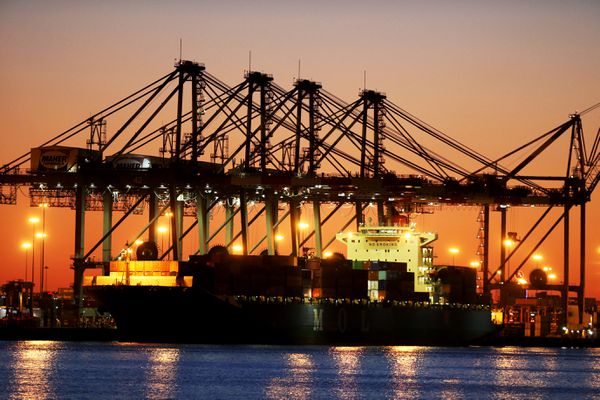The modern port system was created in Newark in April 1956, when a refitted oil tanker carrying fifty-eight trailer-sized steel boxes sailed from Newark to Houston, launching the beginning of container shipping.
Most than 60 years later, parts of the port still look much like it did then. And with a huge increase in the amount of cargo now coming into the marine terminals serving the New Jersey and New York region — as well as the impact of global warming on port operations — billions will be needed to remake the waterfront in the coming decades, officials warn.
In a new master plan to be released Tuesday, obtained by NJ Advance Media, the Port Authority of New York and New Jersey said while the seaport’s existing facilities vary significantly in age, much of the critical waterside infrastructure was originally constructed before 1950.
“Over the next 30 years, the Port Authority plans to make significant investments to assess and replace mission-critical wharf and berth infrastructure,” the study said.
The findings come as the Port of New York Harbor set a new all-time record for cargo during the first five months of 2019, pushing it ahead of Long Beach, Calif, as the second busiest in the nation for the first time in two decades.
With the maritime industry being dramatically transformed with bigger ships, along with changing patterns in international trade and automation, the report said the port needs not only to be upgraded and modernized, but to also prepare for the possibility of higher tidal surges that could affect the port.
“We were the first container port in the world, and we need to rebuild that infrastructure, hopefully making it more resilient to rising sea levels,” said Bethann Rooney, the Port Department’s deputy director. She could not put a price tag on such a rebuilding effort, but said it would be in the billions.
Rooney added that as manufacturing continues to shifts from China to the Africa subcontinent, the port here will be seeing more of those Chinese goods coming to the East Coast rather than the ports on California, putting further pressure on moving that cargo.
The sprawling seaport that stretches from Port Newark and Port Elizabeth, to marine terminals in Bayonne, Staten Island and Brooklyn, is already a huge economic engine for the region. The master plan noted that over the past 15 years, the port has seen consistently steady growth in cargo volumes, and substantial investments have been made to bring in the bigger ships that have transformed the industry.
The report, looking forward to 2050, said the port has an opportunity to "enhance its position within the global marketplace and efficiently respond to ever-increasing cargo volumes and vessel sizes.”
The Port Authority — which serves as the landlord for the port’s big container shipping terminals’s — has already earmarked millions in its current capital plan for maintenance and improvements for some of the areas where ships tie up to deliver and take on cargo, including wharf reconstruction and building demolition. The agency also spent more than $1.7 billion to raise the roadway of the Bayonne Bridge to open the way for bigger ships at the ports in New Jersey, and has invested millions more to deepen channels.
Sam Ruda, the director of the Port Department, said the condition of the waterfront in New York and New Jersey today varies.
“You can’t paint it with a broad brush. We have wood pilings that have degraded. Oddly enough, the fact the harbor is getting cleaner is actually accelerating some of that deterioration,” he observed.
Not addressed in the report is the always present political calculus and unfettered interstate rivalries between the New York side and the Jersey side of an interstate agency whose commissioners always keep score over how billions of dollars in agency funds are divvied up. For decades, that has worked against major port improvements, with 85 percent of the port’s waterfront activity is now centered in New Jersey.
Indeed, the report still calls for new investment in Red Hook marine terminal in Brooklyn, a money-losing marine terminal that cannot accommodate most ships, but still gets millions in public funding from the Port Authority.
Ruda said Red Hook remains in the mix because it is still a Port Authority asset.
“Obviously there is a constituency that wants to keep it a maritime terminal,” he acknowledged. “The focus of the master plan was basically to keep all optionality on the table.”
